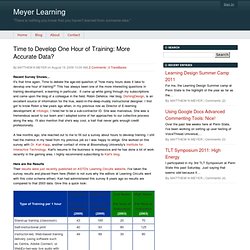

Chapman Alliance: LMS Selection Services, Learning Technology Consulting, Choosing an LMS - How Long Does it Take to Create Learning? How Long Does it Take to Create Learning?

Click icon in the lower-right-hand corner to take the slides full screen. Download the PowerPoint for FREE through Slideshare.net (after opening full screen) Executive Summary: Research Participants: 249 companies organizations, representing 3,947 learning development professionals, who have created content consumed by 19,875,946 learners. Estimating Costs and Time in Instructional Design. Note that budgeting is not included in most ISD models, but as more and more Learning/Training Departments are being called upon to justify their expenses, I'm including it here.

Budgeting Learning activities are budgeted in a wide variety of ways, so the degree of estimating the costs will depend upon the organization you are working for. Generally speaking, the closer you are to your customers or clients, the less you have to estimate. How Long Does it Take to Create Learning? Time to Develop One Hour of Training: More Accurate Data? - Meyer Learning. Recent Survey Shows...

It's that time again. Time to debate the age-old question of "how many hours does it take to develop one hour of training? " This has always been one of the more interesting questions in training development, e-learning in particular. It came up while going through my subscriptions and came upon the blog of a colleague in the field, Robin Defelice. Her blog, DishingDesign, is an excellent source of information for the true, waist-in-the-deep-muddy instructional designer.
A few months ago, she reached out to me to fill out a survey about hours to develop training. Here are the Results I notice a number of things here but these two stand out to me: The 2009 numbers seem much more 'averagy' (yes, I just used that word). So Why is This? Based upon my experience in 17 years in this 'business' of instructional technology/design/e-learning development or whatever else we call it these days, I believe the 2009 numbers are fairly accurate to each category.
Yes. Time to Develop One Hour of Training. Designing training is as much of an art as it is a science.

However, that doesn’t mean we should abandon the act of trying to figure out how long it takes to develop an hour of training. Scientific measures and standards can be applied at least as rough guidelines. With some type of standard, it becomes possible to gain a general idea of how much time a training project might take. While many may argue about using “one hour of training” as a measuring stick because of the difficulty of determining exactly what one hour means, it is a common term and has some traction with managers trying to plan resources. It’s not perfect, but it is a way of making comparisons. Too often when asked about developing training, internal and external clients hear “it depends.” Here are the results from a survey we developed in a rough attempt to align credible numbers for use in estimating work based on delivery method and complexity of interactivity.
Demographics Results. New Mexico Department of Information Technology - Project Management Templates & Guidance. Time Estimates for E-Learning Development. One skill I’m constantly trying to improve is estimating how long it will take to complete a project.

Because I work for myself, I have to create good estimates. If I don’t, I either bid low and lose money or bid high and lose a project. The two sources I use for benchmarks are Bryan Chapman’s research and Karl Kapp’s ASTD research. Of the two, I usually go for Chapman’s data, since it’s broken down with more detail. Time Tracking Template for Instructional Design. As an instructional designer, I often need to estimate the time it will take to complete a project.

One tool I use for determining my estimates is records of how long past projects have taken. Having everything together in a spreadsheet also simplifies my invoicing to clients. In addition, I track non-billable time. That’s primarily for my own interest; I want to see how long I spend on administrative tasks like invoicing as well as networking and marketing tasks. I use a Google spreadsheet for this. Tips I use Ctrl+; to add the current date quickly.Time Spent will automatically calculate once you add your Start Time and End Time.Leave the Invoiced column blank until you have actually sent the invoice. Pivot Table I use a pivot table to analyze how I spend my time. You can adjust the pivot table to group by phases instead of quarter and month. You can also filter the pivot table by whether tasks or billable or not, client, phase, etc.
Feel free to use this template yourself. 12 Tips for Accurate Project Estimating. Projects typically involve many dynamic aspects, yet they're often constrained by finite conditions.

These contradictory forces make it very difficult to determine with pinpoint accuracy the time and effort required. By using a set of proactive estimating techniques to scope, plan, and constrain your project conditions, you can dramatically improve your estimating practices, reduce and mitigate risks, and increase your project success rate. Do you excel at predicting the time, funding, and resources your projects will require? Ten Steps to Estimate Effort on Your Project.